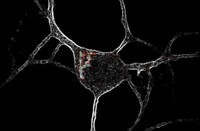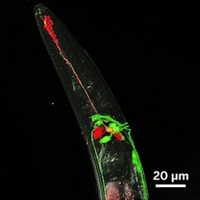Advertisement
Grab your lab coat. Let's get started
Welcome!
Welcome!
Create an account below to get 6 C&EN articles per month, receive newsletters and more - all free.
It seems this is your first time logging in online. Please enter the following information to continue.
As an ACS member you automatically get access to this site. All we need is few more details to create your reading experience.
Not you? Sign in with a different account.
Not you? Sign in with a different account.
ERROR 1
ERROR 1
ERROR 2
ERROR 2
ERROR 2
ERROR 2
ERROR 2
Password and Confirm password must match.
If you have an ACS member number, please enter it here so we can link this account to your membership. (optional)
ERROR 2
ACS values your privacy. By submitting your information, you are gaining access to C&EN and subscribing to our weekly newsletter. We use the information you provide to make your reading experience better, and we will never sell your data to third party members.
Biological Chemistry
More Than Just Pores
Ion channels can also act as enzymes and communication links
by Carmen Drahl
March 3, 2008
| A version of this story appeared in
Volume 86, Issue 9

As if ion channels weren't doing enough on their own—underpinning nerve impulses and muscle contraction—researchers are now finding that they can do even more as team players in the cell.
Voltage-gated ion channels are membrane pores that sense changes in local charge distribution across membranes. They open and close in response, ushering ions into and out of cells to propagate electrical signals. Such channels were once thought to be lonely thoroughfares. But a symposium at the 52nd Biophysical Society Annual Meeting and 16th International Biophysics Congress, held last month in Long Beach, Calif., brought attention to these proteins' other roles.
"Today, I'd like to challenge you to think about voltage-gated ion channels in a different way," said University of Michigan, Ann Arbor, pharmacologist Lori L. Isom, setting the tone for the "Non-Conducting Functions of Ion Channels" symposium. Isom and three other speakers presented evidence that ion channels do other things besides gatekeeping: They can participate in cell-cell interactions and they can catalyze reactions.
The biological consequences of the ion channels' other jobs are not yet completely clear. But they may be vital for diseases such as cardiac arrhythmia, ataxia, and some types of epilepsy, which may be connected to ion channel defects but not necessarily to changes in current flow.
"There are about 50 inherited disorders of ion channels, and we want to understand them genetically and tease out their molecular mechanisms," said symposium attendee Alfred L. George, chief of Vanderbilt University Medical School's Division of Genetic Medicine and an expert on mutations of human ion channels.
For neurochemist Leonard K. Kaczmarek of Yale University, who did not attend the symposium, the idea that ion channels could influence biochemical pathways in the cell is "the big punch line" in the story of ion channel research. In the 1970s and '80s, it became clear that ion channels could be regulated by biochemical pathways, he says. For example, investigations showed that channels act as substrates for kinases, enzymes that regulate biological processes by phosphorylation. Subsequent studies showed that ion channels form complexes with kinases. However, "it was always thought that the ion channel itself was the passive endpoint of signaling regulation," Kaczmarek says.
At the Biophysical Society meeting, two researchers delivered Kaczmarek's punch line, discussing how two different classes of ion channels can themselves act as kinases. Symposium chair Federico Sesti, a biophysicist at the University of Medicine & Dentistry of New Jersey, in Piscataway, described a kinase that is part of a voltage-gated potassium ion (K+) channel in worms. University of Pennsylvania School of Medicine neuroscientist Irwin B. Levitan reported a similar kinase in flies that is associated with a K+ channel that opens and closes in response to both voltage and calcium concentration.
Voltage-gated K+ channels help nerve cell membranes return to their resting state after a nerve impulse. Their biological activity is fine-tuned by regulatory β-subunits, proteins tightly associated with the channel. Sesti's kinase is a K+ channel β-subunit, and in vitro it phosphorylates the K+ channel to which it is attached. That action appears to affect current flow through the pore.
Sesti's latest results indicate that the kinase subunits affect habit-based learning in worms. "This type of learning allows you to filter information," Sesti said.
Usually, worms are sensitive to touch and will recoil from a tap to their bodies, Sesti explained. Eventually, they habituate to repeated poking. He observed this response for normal worms, but mutant worms with a defective kinase didn't get used to the poking nearly as quickly. However, it's too early to apply Sesti's findings to learning disabilities in people because scientists have yet to find similar β-subunits in more advanced animals.
Not every channel β-subunit is a kinase. Structural and functional work by several groups suggests that β-subunits in voltage-gated K+ channels act as oxidoreductases and even hint that ion flow through the pores is coupled to the enzymes' activity.
For example, Columbia University structural biologist Ming Zhou and coworkers recently confirmed that these β-subunits catalyze an oxidation/reduction reaction. Zhou discussed this work at the meeting. His team found that the β-subunits catalyze the reduction of aldehydes to alcohols, simultaneously oxidizing an NADPH cofactor to NADP+.
In addition, Zhou and coworkers have shown that the β-subunits' enzymatic activity increases current flow through the K+ channel in vitro. Inducing cofactor turnover by adding an oxidant such as hydrogen peroxide rather than adding an aldehyde substrate also increases current flow. "All you need to do is oxidize the NADPH cofactor on the protein to modulate channel activity," Zhou said. He is currently working toward understanding the structural basis of changes in current flow. A high-resolution structure of the β-subunit together with an entire channel was recently determined by Roderick MacKinnon's team at Rockefeller University and is providing a framework for these efforts.
β-Subunits are profoundly important not only to the K+ channels but also for their counterpart, the voltage-gated sodium ion (Na+) channel, Michigan's Isom pointed out. Na+ channels open and let sodium ions rush into nerve cells, making the insides more positive. Knockout mice lacking a specific type of Na+ channel β-subunit, Isom said, resemble the mouse model for pediatric epilepsy and have defects in nerve growth and development.
This may be because Na+ channel β-subunits serve as communication links during development. β-Subunits mediate cell adhesion, resulting in their interactions with kinases that are necessary for the sprouting of outgrowths from developing nerve cell bodies. "β-Subunits act as the glue to [stick] specialized signaling molecules to the channel pore," Isom explained.
Other groups have shown that some people with inherited epilepsy have mutations in Na+ channel β-subunits. Isom's team has shown that at least one of these mutations disrupts β-subunit-mediated cell adhesion. This finding could mean that loss of cell-cell communication is important in the development of the disease.
The field is far from finding cures for epilepsy or any other disease. But as neuroscientist and symposium attendee Diane Papazian of the University of California, Los Angeles, commented, understanding how ion channels can communicate with their surroundings is an important research direction. "In the last 20 years we were focused on how channels work and how that relates to structure," she said. "We know a lot about this, particularly in the K+ channel field, but the wave of the future is to learn how they function in a cell with lots of other receptors and channels around—what they do in biology."




Join the conversation
Contact the reporter
Submit a Letter to the Editor for publication
Engage with us on Twitter